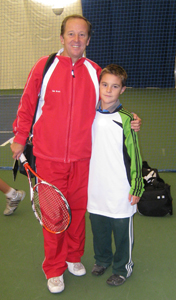Bob Brett: 5 Qualities To Hang On Your Bedroom Wall
 Saturday, November 19, 2011 at 10:47PM
Saturday, November 19, 2011 at 10:47PM  CAtennis
CAtennis  From a recent interview, Bob Brett shared 5 characteristics of a champion. It's safe to say Bob Brett is a humble spirit who possesses a wealth of experience from working with world class players on the tour. His notable players include Becker, Ivanisevic, Medvedev, Ancic, and Cilic. The most impressive quality about Bob is the length of time he worked with each player.
From a recent interview, Bob Brett shared 5 characteristics of a champion. It's safe to say Bob Brett is a humble spirit who possesses a wealth of experience from working with world class players on the tour. His notable players include Becker, Ivanisevic, Medvedev, Ancic, and Cilic. The most impressive quality about Bob is the length of time he worked with each player.
Here are the 5 qualities of a champion according to Bob Brett:
1) World class talent. The ability to learn. The ability to see the court. Intuitive skills.
2) Play one's best when it counts the most.
3) Be able to push one's self to do the right thing. How strong is one's character to do the things one does not want or like to do. Do the right thing with one's behavior, training, and to stay disciplined.
4) To overcome difficulty. It could be injury, confidence, keeping one's mind through it all.
5) Loyalty to what you want to do. Believe what you are doing is the right thing and what you want to do. Choosing the right people to work with and trusting them, not turning to someone else when difficulty comes. Disruptions in coaching break develop and one should be cautious of such changes. The best players had very few coaches.
After reading through the list, let's discuss each point in how it relates to junior/college players.
1) World class talent- yes, one could argue each player is born with it or not. However, if one has a high ability to learn (love for the game) and willing to put in the time (10,000 hours), they can reach their own potential. Most juniors/college players do not have the ability to LEARN HOW TO LEARN. Without love or thirst for learning (just give up!), tennis is too hard. To the PARENTS- just give up and stop fighting a losing battle if your dreams are to make your child something he isn't (big time D1 scholarship or world class player).
2) Play one's best when it counts the most- This one you can't teach, but it can be helped along by putting kids into pressure situations more often. This includes dominating your own age division before moving up, not ducking tournaments, playing all the tournaments regardless if you are #1 seed, playing atleast 8-10 practice sets a week against people at your OWN LEVEL, and not substituting lessons for matchplay. Have to practice being in pressure situations. Non-PRESSURE situations include jetting around the world playing ITFs, chasing points at National Junior Events, playing Professional events, ducking Nationals after you signed with a college, taking lessons over matchplay, etc.
3) Be able to push one's self to do the right thing- This comes down to character and usually the guidance and parenting a child receives. Be honest, don't cheat, be self-motivated...all qualities of someone of high character. Children look to copy their role models (other good players, so beware if they are acting like idiots), parents, and coaches.
4) To overcome difficulty- again, this is a character issue. The parents can help foster a child to respond to difficulty in an encouraging way.
5) Loyalty- again, not looking to place the blame on others but yourself if things don't go your way. Starts with the parents again.
Notice how Bob Brett didn't talk about forehands, backhands, serves, and spin ratio on the slice backhand (that ain't it!). Enjoy!





